Table of Contents
- Summary; why bard?
- Level choice breakdown (1-16)
- General strategy
- Market decisions; always, often, situational buys and special cards
- Hero specific matchups
- Alternative build and other musings by IGN Lgkstwrt
Summary; why bard?
Hero Realms for many of us provides different routes to joyful success, whether it be crushing your opponent through sheer force as a brutal fighter with a peculiar love of all things shiny and flammable, recreating a look of sheer frustration in your opponent’s eyes game after game of hands discarded and market control, or realizing there isn’t much else to compare to reading a real page turner with a cup of bushell’s finest as you spend the next 2 hours slowly leaving someone at an inevitable loss through clever cleric chess-like play.
For those lucky enough to have managed to get access to beta there are then further dynamics at hand to create devastating play, and with how young these heroes are in testing there is still a lot to be discovered in each hero’s deck mechanics.
Of the Beta heroes (Alchemist, Monk, Barbarian, Druid, Bard and the Necromancer), there is one that I have personally enjoyed the struggle of piloting considering its quite complex mechanics and apparent lack of success in the community. At the time of writing this article I’d successfully brought the first bard into the top 1000 rankings and up to Diamond, with a fellow community member lgnkstwrt (IGN), who will be adding valuable contribution and input to this article, seemingly on his way to join my bard in diamond with his very own.
![]()
Lgnkstwrt, famed for keeping snake pet ranger builds in the meta and for a number of base articles on RealmsRising.com covering essentials of beginner play including evaluating differences between paper and digital play (titled ‘Errata’), ‘Rank, Prestige and Leaderboard’ overview, sacrifice tips (titled ‘Into Tyrannor’s Maw: Techniques on Sacrifice’) and even covering common early pitfalls (titled ‘Cheat Codes – Tips on Avoiding Common Pitfalls in the HR app). Not only proficient in the above, but he has shown his proficiency in the community displaying high levels of tournament play and by organizing the Banned! tournament.
This article will try to be quite expansive in its discussions on Bard play, and hopefully bring notes of inspiration into many more songs of fortune and fruitful play for many a future Bard player!
Level choice breakdown (1-16)
The following level breakdowns will briefly go over reasoning for each level choice, with a further understanding of why each decision was made developing as you progress through the article.
If you’re someone who wants the TL:DR version, see as follows the complete build at level 16:
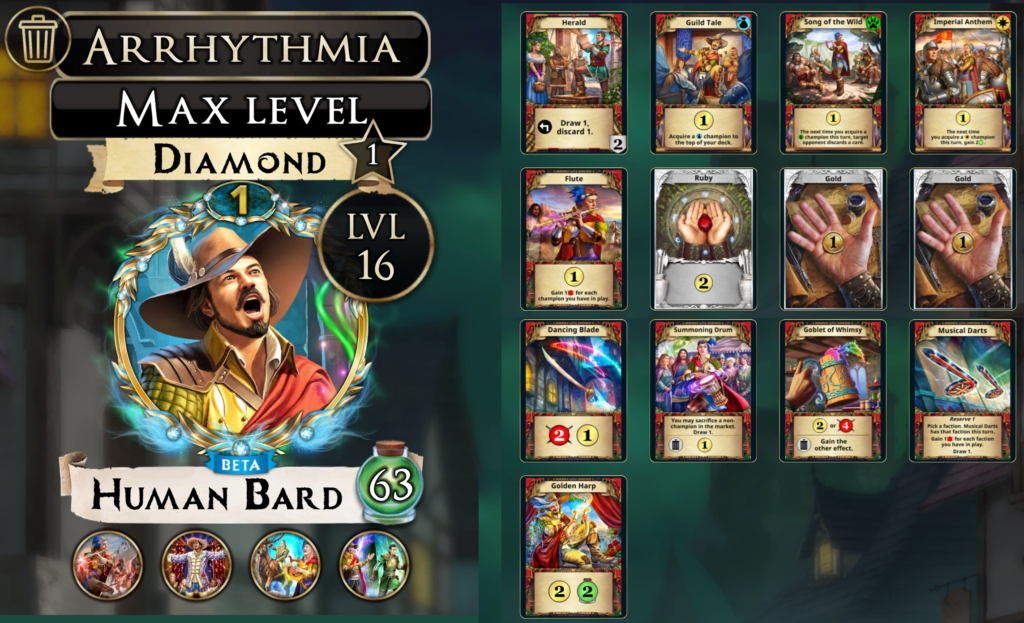
Base deck (ability 1-3):
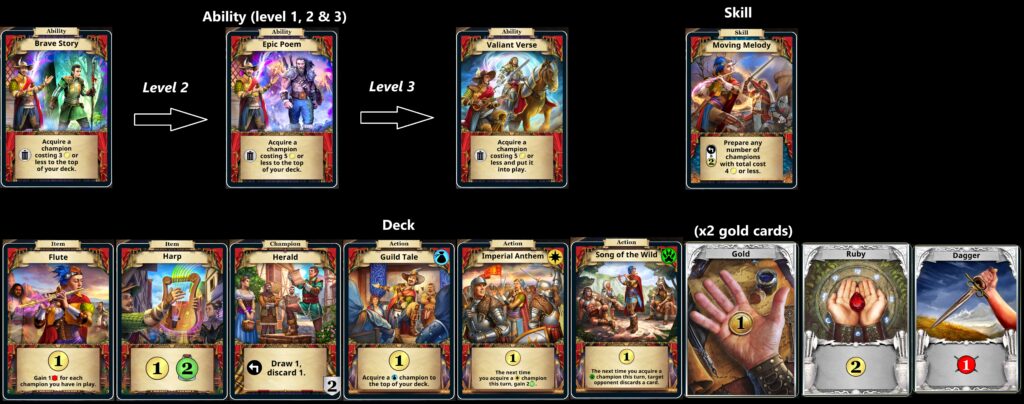
Your base deck prior to any decision making; two of these cards will be replaced as you progress through the levels, with the other 8 remaining unchanged up to level 16.
Level 4:
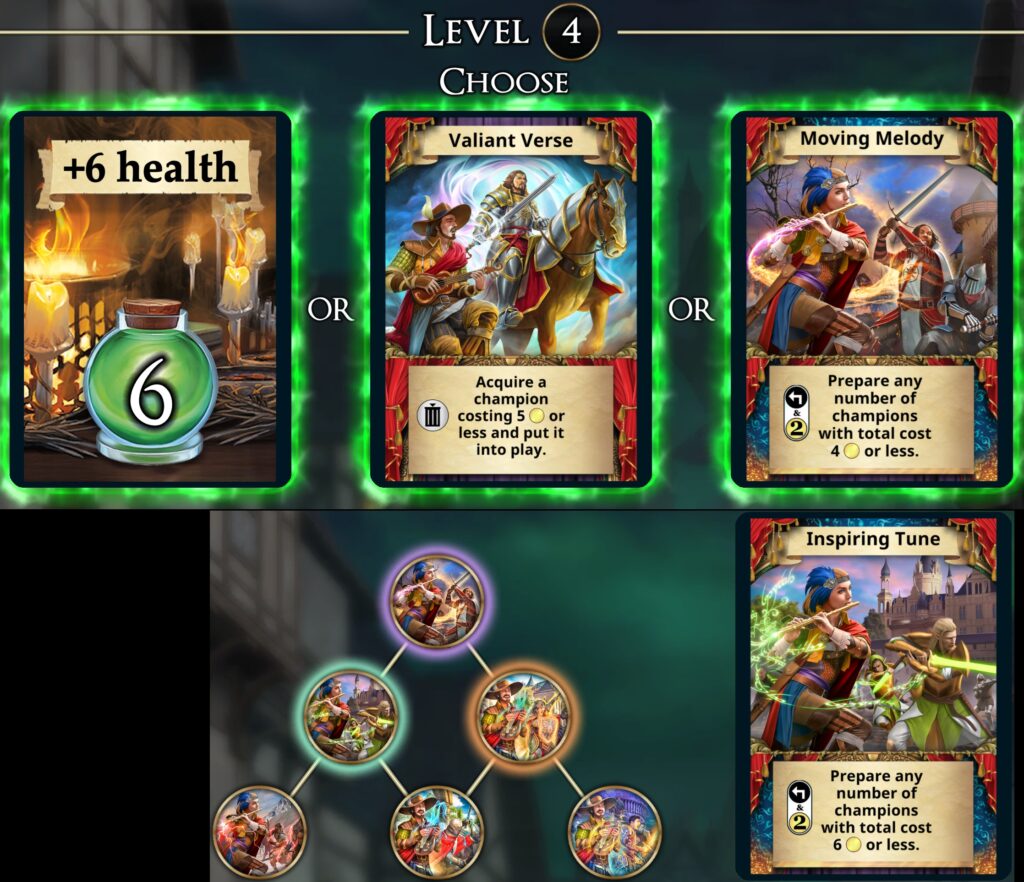
It is at level four the decision to move towards upgrading your skill or your ability first is made. Considering the utility of your skill to consistently produce significant damage output, force discards by preparing a discard champion, increase healing effects and so forth, it is this pathway chosen first to upgrade. Choosing the left side of the skill tree gives us the opportunity to work towards the end ability of preparing any number of champions of total cost 10 or less. Preparing champions of cost 6 or less is still quite worthwhile, considering the number of viable champions in the market; ‘Cron – The Berserker’, ‘Kraka – High Priest’, ‘Lys – The Unseen’, and so forth.
Level 5:
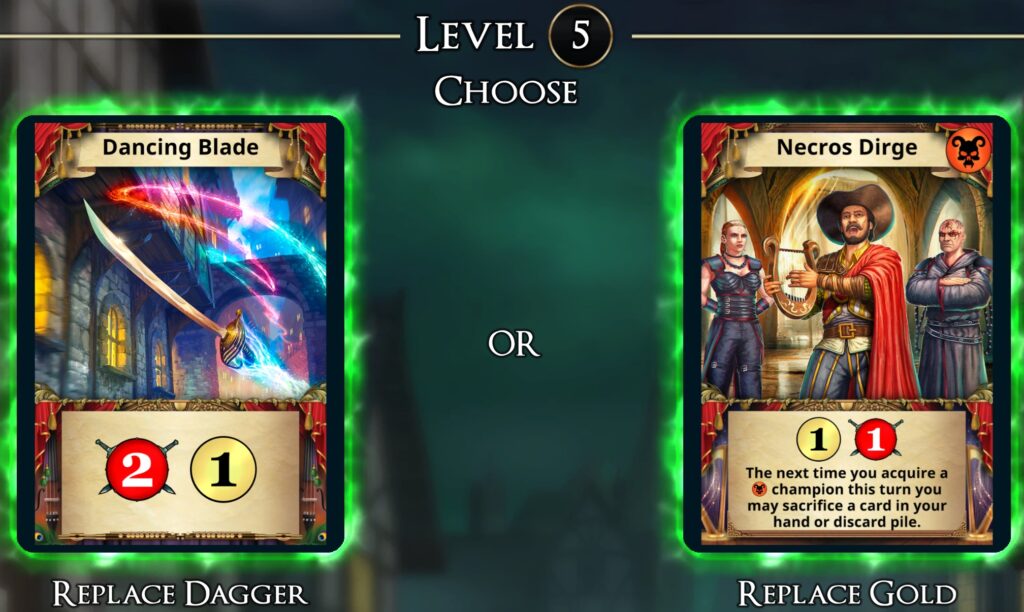
Two weaknesses of the bard class is deck stagnation and low deck total combat. As extensively outlined in the next section Bard needs to win quickly, with games dramatically shortening as you surpass the armour choice at level 9.
Doing so requires you to be able to make game changing purchases in deck 1 and to resist deck bloat with economy cards that cannot be removed such as ‘Bribe’ or ‘Profit’. If you find yourself missing a premium purchase deck 1 and having to purchase economy, this delays your deck from picking up pace until the 3rd shuffle, with some inconsistent compensation by top-decking with your low-level ability or situationally with your ‘Guild Tale’ card.
The second issue of low deck total combat leaves you at risk of being walled by champions in the early game due to an inability to clear them from opposing bards, druids, clerics and other players using this strategy. Not having enough combat could also put yourself in a position where you aren’t able to clear a wizard’s ‘Cat Familiar’ champion, allowing for a premium market purchase by the opponent from that additional gold.
Taking the above into consideration, whilst trialing both extensively in community-led competitions and queue, the first choice of replacing the dagger with ‘Dancing Blade’ was found to be a lot more consistent. Replacing the ‘Dagger’ card means that it is now impossible for your starting hand to have more than 1 non-economy card, raising a 3 card turn 1 to 2 minimum economy, and a 5 card turn 2 to a minimum of 4 economy. This effect is even more profound once the ‘Herald’ champion is in play or misses a deck shuffle, as now there are no non-economy cards to draw (pending market purchases), increasing your economy ceiling for higher cost market cards. The second benefit is the ability to clear champions, where the ‘Dancing Blade’ is now enough to take out a wizard’s ‘Cat Familiar’ champion without having to use your ability prematurely.
Level 6:
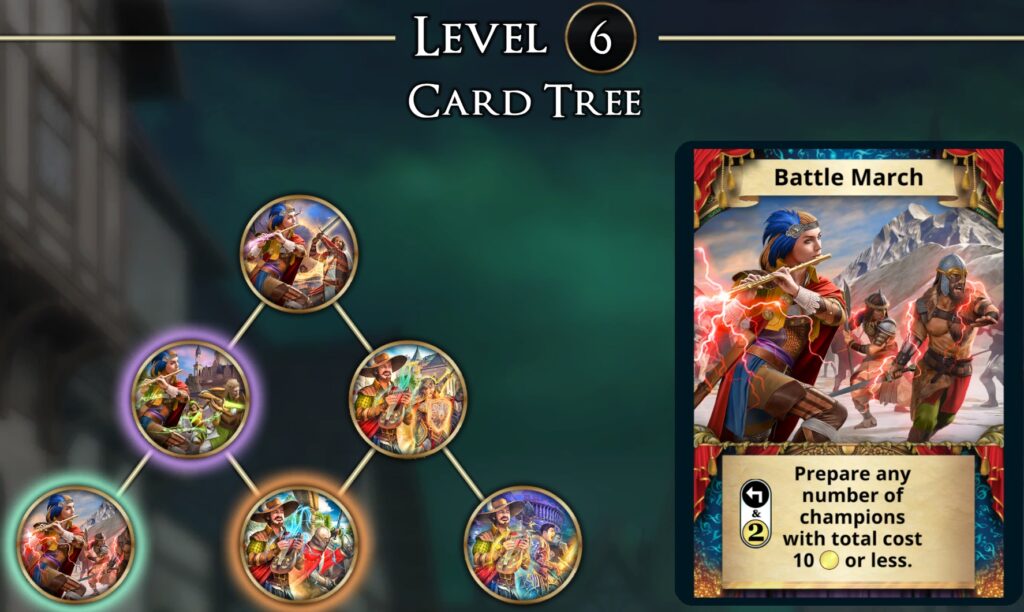
Level 6 is along the same line of thinking as elaborated on for the level 4 choice by reaching your maximum skill level prior to moving towards upgrading your ability. This now opens up your skill application to ALL champions and a wider array of combined champions, allowing for combinations of economy champions with combat focused champions, discard champions and those which provide cycling, and so forth. This is particularly necessary to keep up the pace to reach earlier turn count victories.
Level 7:
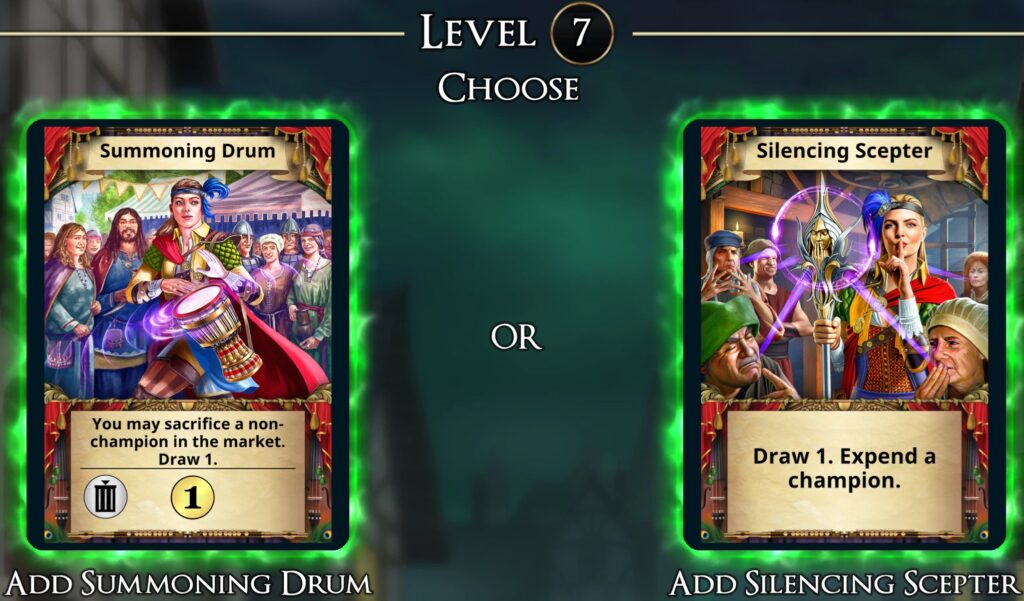
Here we have a choice between essentially market control and economy with ‘Summoning Drum’, or champion management with ‘Silencing Scepter’. ‘Summoning Drum’ has a number of key benefits which place it well and truly above ‘Silencing Scepter’ as the card of choice.
Firstly, this card allows you to remove an action from the market, allowing you to make a premium purchase, perhaps of ‘Torgen – Rocksplitter’, whilst removing ‘Firebomb’ from the row, or even purchasing ‘Wolf Form’ and removing ‘Elven curse’ from the row. Essentially, you’re using this card to give yourself a hot buy whilst denying one from your opponent, obviously having to choose the champion option if its present amongst other great purchases considering this card only removes actions.
Secondly, this card is scrapable/removable from your deck for 1 extra economy. This gives your 3 card starting hand an economy ceiling of 5, and a 5 card starting hand a ceiling of 7 economy.
Silencing Scepter may be situationally beneficial in matchups where you are up against heroes who start to develop early champion walls, such as the druid class and its Bear form ability variants. However, this does not stun the target champion so the turn after if you do not have the combat to clear the champion, it returns to its prepared state resuming the issue at hand. Essentially, when you find the most use of this card its often in game losing scenarios with multiple opposing champions on the board.
Level 8:
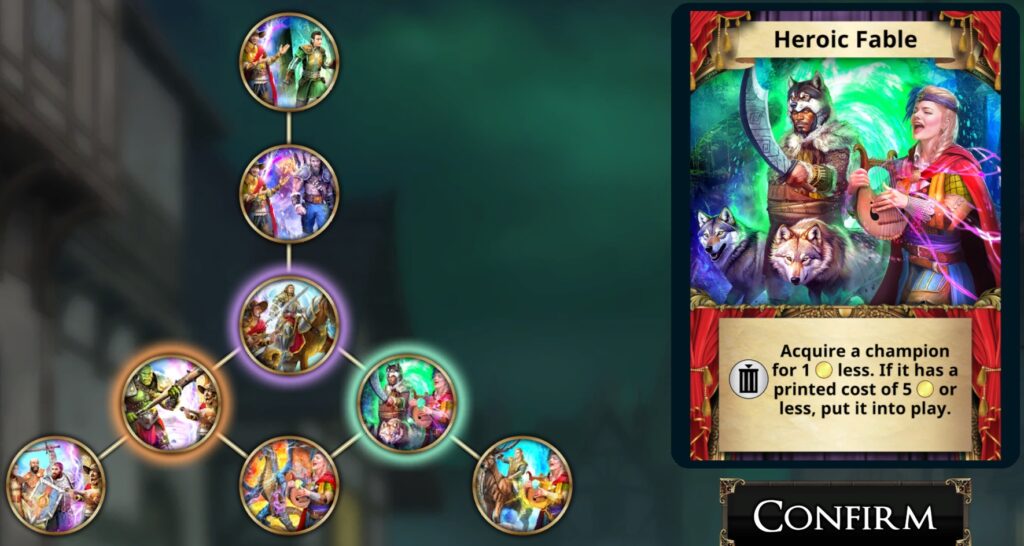
Now it’s finally time to upgrade our ability to ‘Heroic Fable’; acquire a champion for 1 economy less, if it has a printed cost of 5 or less, put it directly into play. Moving towards the right side of the ability tree focuses on reinforcing our economy advantage and capability to purchase more expensive champions for our next deck or bringing champions of cost 5 or less directly into play. Having taken the ‘Dancing Blade’ as a replacement to our dagger and ‘Summoning Drum’ as the level 7 upgrade choice, we’re in a position where it is impossible for a starting 5 card hand to not have at least 4 economy, and likely more considering herald could cycle a single economy card out for ‘Summoning Drum’ or even a ruby.
Level 9:
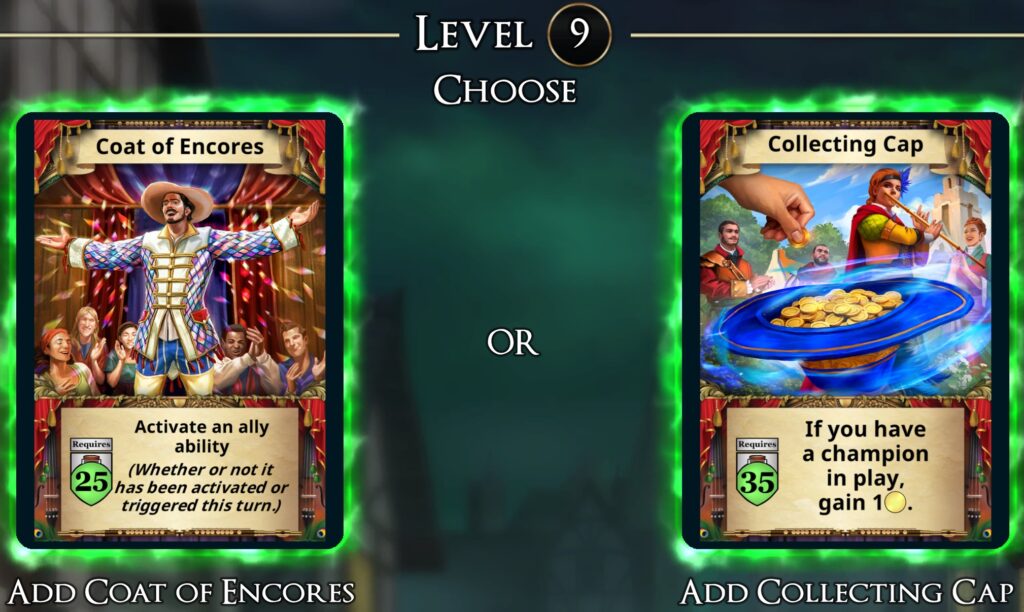
This should be a pretty obvious choice. Do you want to beg for spare change or dazzle onlookers with a spectacular show, demanding an encore!
‘Coat of encores’ armour gives incredible flexibility over the use of market cards, especially in combination with the songs in your deck. Similar to alchemist hero play a market card’s ally ability is just as important now, and in some cases more so, when deciding whether to purchase and add it to your deck. Healing cards such as ‘Taxation’ and ‘Confiscate’ now provide 6-12 healing if paired with ‘Imperial Anthem’ and using your armour to activate the ally ability a second time, discard cards such as ‘Nature’s Bounty’ can cause your opponent to discard 1-2 cards in a similar sense, draw cards 1-2 draws, and so on. Ally abilities which are particularly important to purchase are those with ‘Prepare a champion’, as combined with your skill, armour and if factioned naturally, can allow for the same champion to be activated 4 times.
For example, let’s imagine a scenario where you have ‘Rally The Troops’, ‘Torgen – Rocksplitter’, ‘Song of the Wild’, ‘Ruby’ and ‘Imperial Tunneler’ cards (you may have purchased this card just to square off your deck).
If played correctly, and with some market luck, this could cause your opponent to discard up to 5 cards! Do you see how?
Playing ‘Torgen – Rocksplitter’ gives you 1 discard, preparing him with your skill (and ‘Imperial Tunneler’ as your skill allows you to prepare any number of champions up to 10 cost total) gives you another discard, naturally factioning ‘Rally The Troops’ with ‘Imperial Tunneler’ to prepare ‘Torgen – Rocksplitter’ gives you another discard, then using your armour to activate the ‘Rally The Troops’ ally ability again to prepare ‘Torgen – Rocksplitter’ AGAIN gives a fourth discard. The last discard depends on market luck with your 2 remaining economy after activating your skill. If there is a cheap Wild champion in the market for 2, such as ‘Wolf Shaman’ or ‘Goblin Guardian’, then purchasing this after playing ‘Song of the Wild’ would give you another discard, forcing your opponent to discard their entire hand (unless they were a robes wizard)! Not to mention the 29 combat you’ve amassed.
Level 10:
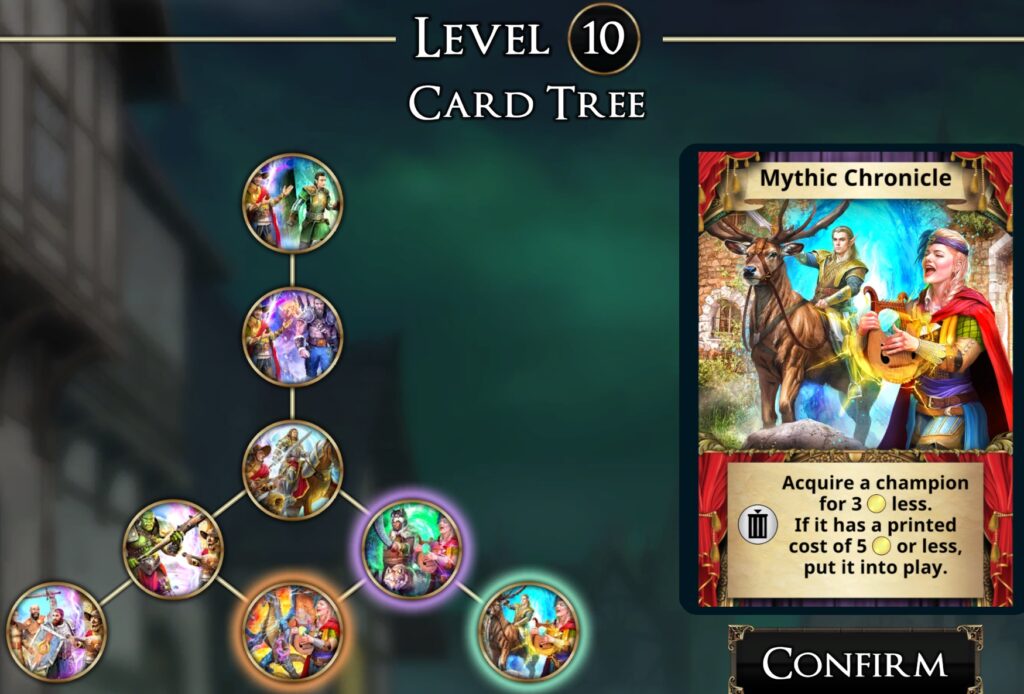
Same reasoning as was discussed for the level 8 upgrade choice with a bigger economy advantage, further discussion of ability use is found in the following section ‘General Strategy’ and the section ‘Market decisions’.
Level 11:
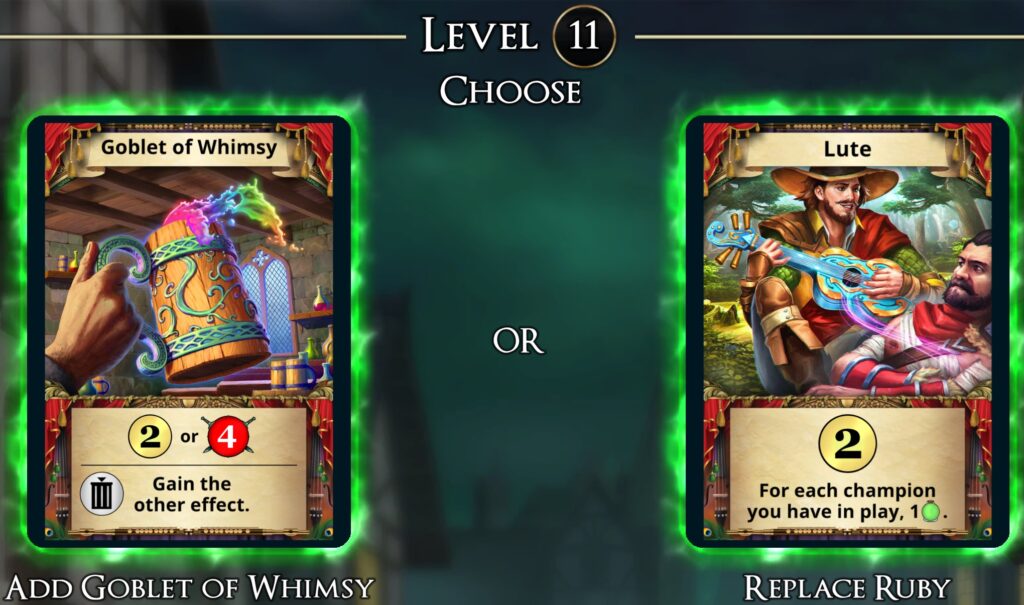
Here we will be choosing the ‘Goblet of Whimsy’ to be added to our deck for two reasons; boosting economy and (usually temporarily) deck combat, with the additional effect of being scrapable to obtain BOTH effects as a once off.
The reasoning behind the economy advantage adding a further 2 gold card to our deck is along the same lines as discussed for our level 5 upgrade choice the ‘Dancing Blade’, and further elaborated upon in the following section on ‘General Strategy’, so I won’t go into significant detail here. Basically this gives you the advantage of making expensive deck 1 purchases without having to bloat your deck with other economy cards, scrap it out for extra damage whilst also keeping it out of your next deck so you’re more likely to draw into your recently purchased market cards.
The 4 combat of this card is also beneficial the same way the ‘Dancing Dagger’ choice was beneficial. Being able to clear early champions, especially those from cleric, druid and other bards, without having to prematurely use your ability is particularly useful.
The ‘Lute’ REPLACING a ruby provides no additional economy advantage. The healing aspect of the ‘Lute’ card (for each champion you have in play, 1 health) is less useful for three reasons. Firstly, games are often won (or lost) too quickly for this card to have provided any significant healing, certainly not in comparison to being able to purchase a number of guard champions/’must stun champions’ (those that provide too much of a disadvantage to ignore and leave out) with the extra economy ‘Goblet of Whimsy’ provides, you’ll find yourself seeing this card twice, MAYBE three times by the end of a standard mid-game. Secondly, if you’ve found yourself with large enough champion wall and a faster cycling deck (via sacrifice, draws or cycle effects), then you’re almost certainly at or near full health and imminently about to win. Thirdly, this is for each champion only, and without champions provides no additional benefit, meaning it’s even further situational in an action dominant market or where you’ve found yourself buying a number of high damage cards with or without beneficial faction abilities, as per the strategy outline in the following section, ‘General strategy’.
Level 12:
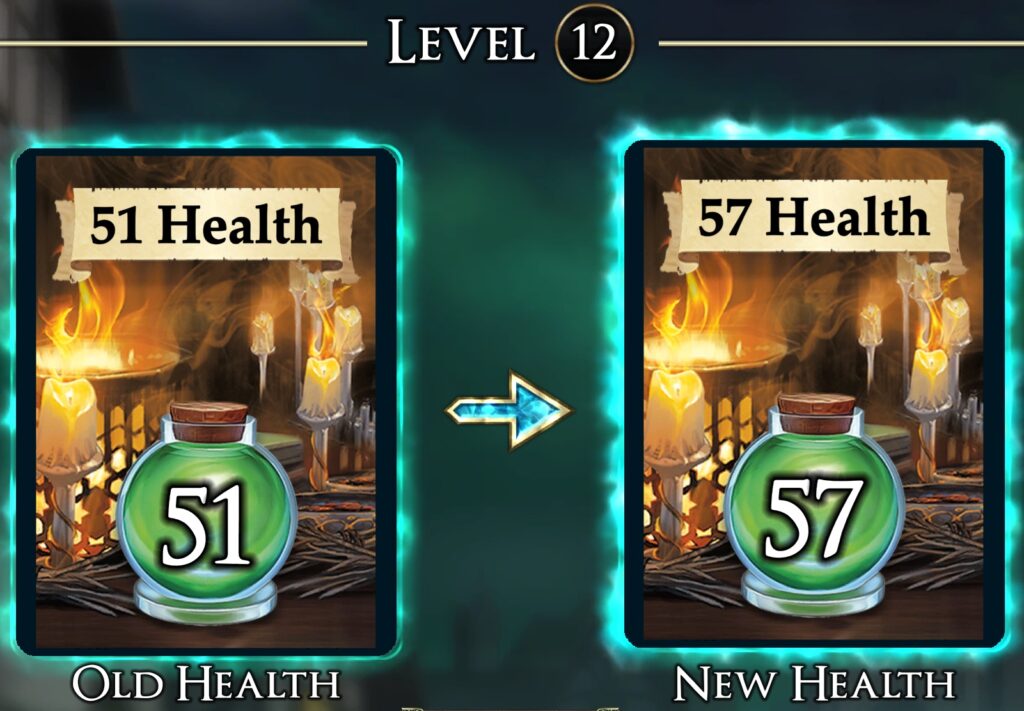
Keeping your armour online, with a health threshold of 25, is more beneficial to your chances of victory than a second ability, especially against more aggressive match-ups.
Level 13:
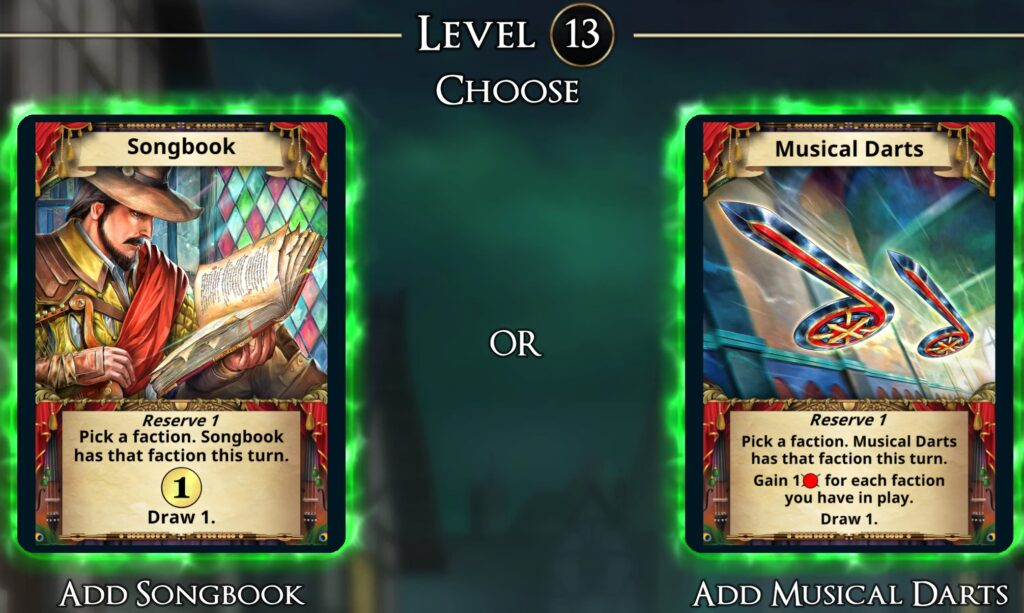
At first, song book was chosen during my first trial of the Bard hero, but I found it often led to game-ending scenarios. Picking a faction for either of these cards is very, very useful, however a specific point to note is you do this BEFORE you draw a card, which can often lead to misses if your hoping to draw into a specific card such as ‘Hit Job’ and faction for Guild but instead draw ‘Orc Grunt’. This can lead to a miss whilst only providing a single gold as its benefit.
The other point to note is the ease in which the Bard hero is ‘Champion-walled’, where you find yourself against an opposing player with a number of champion cards in play you are unable to clear, snowballing on each successive turn leading to your armour being switched off and often an eventual loss. This is where I found more consistent benefit from having ‘Musical Darts’ added to my deck.
There are two common ways to use this card. One is as mentioned above where upon after placing ‘Musical Darts’ you choose a faction for it to have and draw a card, hoping to draw into a particular card in your deck to activate that card’s ally ability. Considering this mechanic it is of particular importance you perform your other draw effects prior to musical darts being played to determine which faction your require to trigger another card’s ally ability; there’s no point in choosing ‘Musical Darts’ to have the guild faction if you’ve then drawn into your ‘Guild Tale’ card, where you could have used your armour to trigger the draw on an orc grunt to draw into ‘Guild Tale’, then drawn with ‘Musical Darts’ after choosing the wild faction, drawn into a gold, activated the draw on the ‘Orc Grunt’ again and finally drawn into ‘Deception’ which you were digging for.
If you miss, ‘Musical Darts’ still provides 1 combat for each faction you have in play (up to a maximum of 4). It’s this secondary function which can be again particularly useful when up against heroes who are champion focused. In these scenarios if your deck does not contain any cards with faction abilities (such as only standard deck cards) you would choose a faction for ‘Musical Darts’ which is purposefully not possible to draw to maximise the extra damage to take out a ‘Cat familiar’, or even the more colloquially known ‘Cocaine Bear’ form of the Druid hero (6 defense) in combination with your ‘Goblet of Whimsy’.
Level 14:
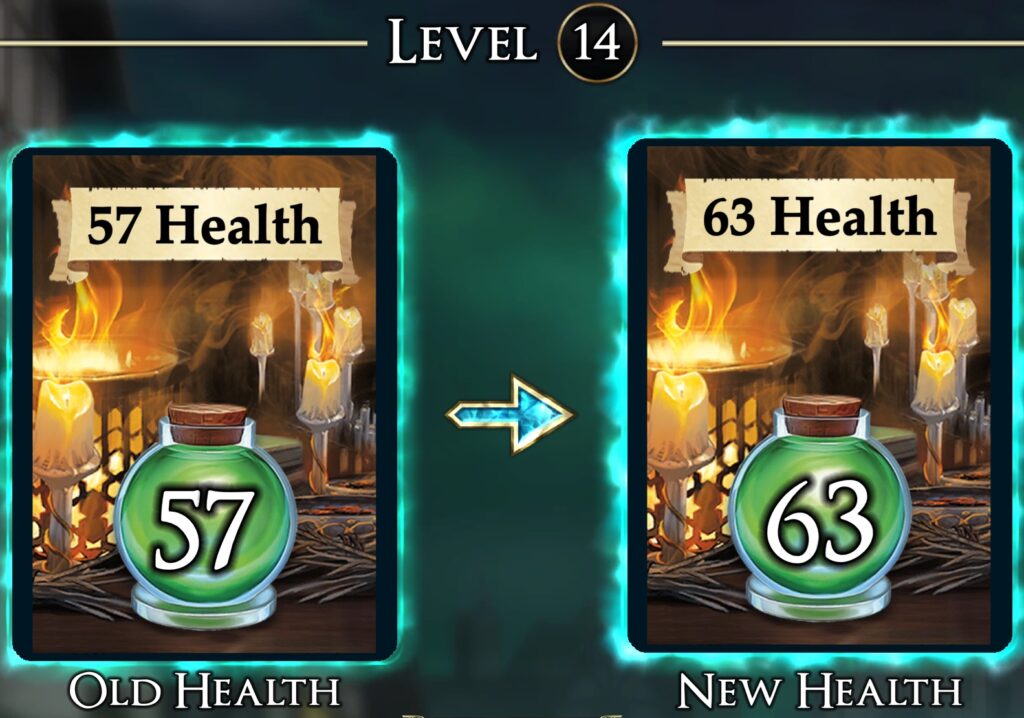
Same reasoning for level 12; KEEP THAT ARMOUR ONLINE!
Level 15:
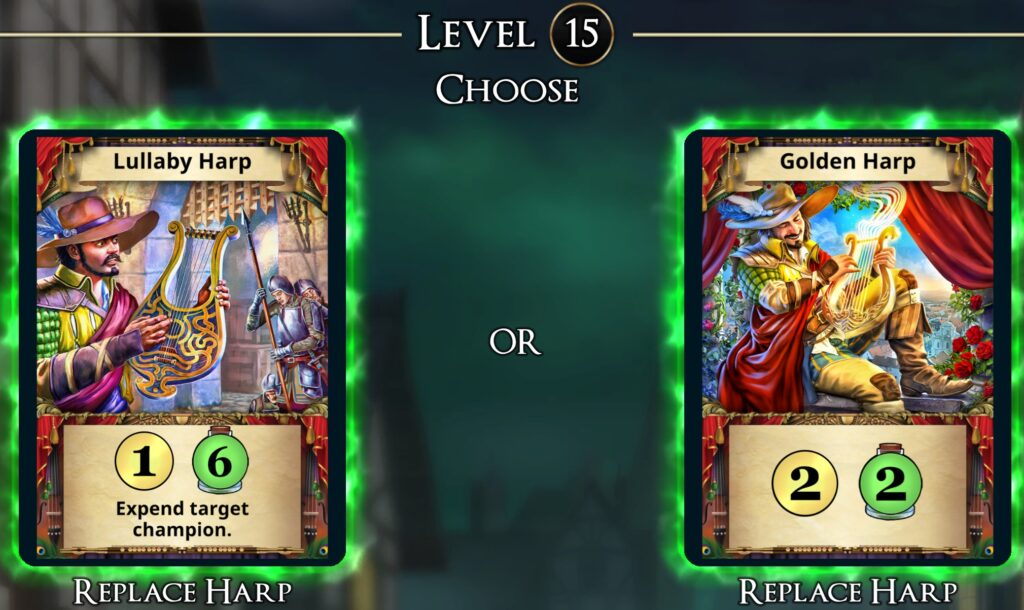
‘Golden Harp’ is particularly helpful in buffering the chances of drawing higher economy hands within (most importantly) your first deck, and in successive decks where you need the two gold for skill use, freeing up other single economy cards for cycling, sacrifice, market purchases, and so forth.
Similar reasons for not pursuing the route of the ‘Lullaby Harp’ were made when not taking the ‘Silencing Scepter’ for the level 7 upgrade choices re: opposing champion control, and the healing aspect as was discussed for the ‘Lute’ choice at level 11.
Level 16:
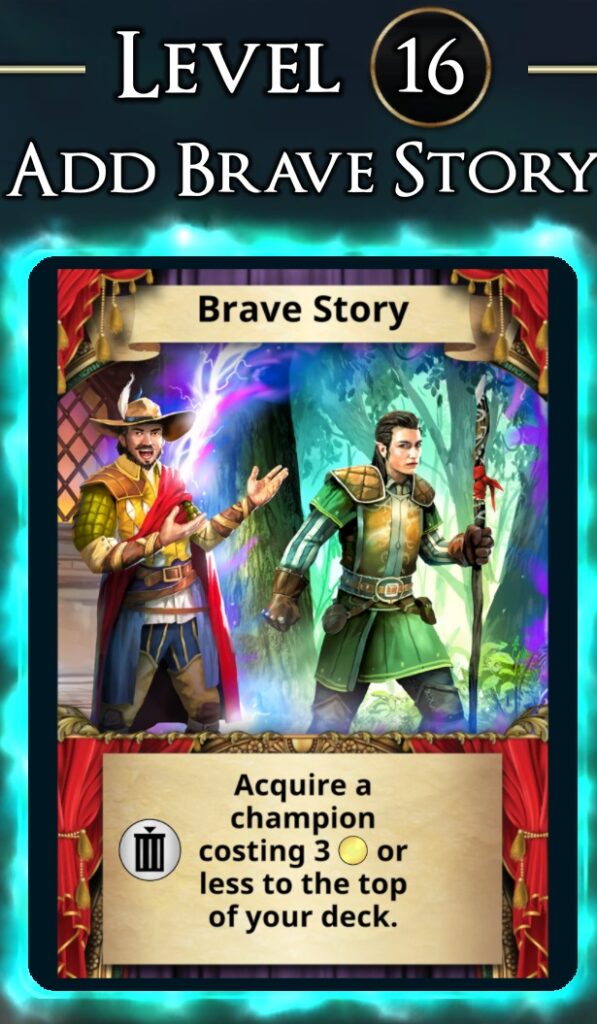
And so ends your upgrades with a secondary ability, let the ‘Brave Story’ begin!
General Strategy
Playing bard well means acknowledging its weaknesses, deck stagnation, or often known in the Realm’s Rising community as ‘bricking’, where you find yourself with a hand that essentially adds no value to your turn. Not enough economy to make a beneficial purchase, no draws to bring preferential cards into play, no damage to stun opposing champions, and so forth. This becomes more devastating to your chances of victory as the game progresses from the mid-game to the late game, particularly against heroes who are inherently resistant to ‘bricking’, such as wizards.
To win consistently you need to be able to end most games by turn 12 for most classes at the higher levels where you have your ability and skill at maximum level. As such deck bloat is a little less important as you’re expecting most games to end before you reach your 3rd shuffle or soon afterwards, so priority for high damage cards is key here, whilst denying healing cards from your opponent and any cards which have beneficial ally abilities. The exception being cleric where games are expected to move out of the mid-game and into the late game, and out champ walling/sacrifice cards become far more important.
Use your songs
As seen earlier the songs within your deck all carry their own faction; ‘Guild Tale’ with guild, ‘Imperial Anthem’ for imperial and ‘Song of the Wild’ has the wild faction. Not only do these cards have their own faction, but they also provide quite useful card effects for their particular faction which makes accounting for how you could make use of these effects VERY important BEFORE you decide on performing irreversible actions, such as discarding and then drawing a card.
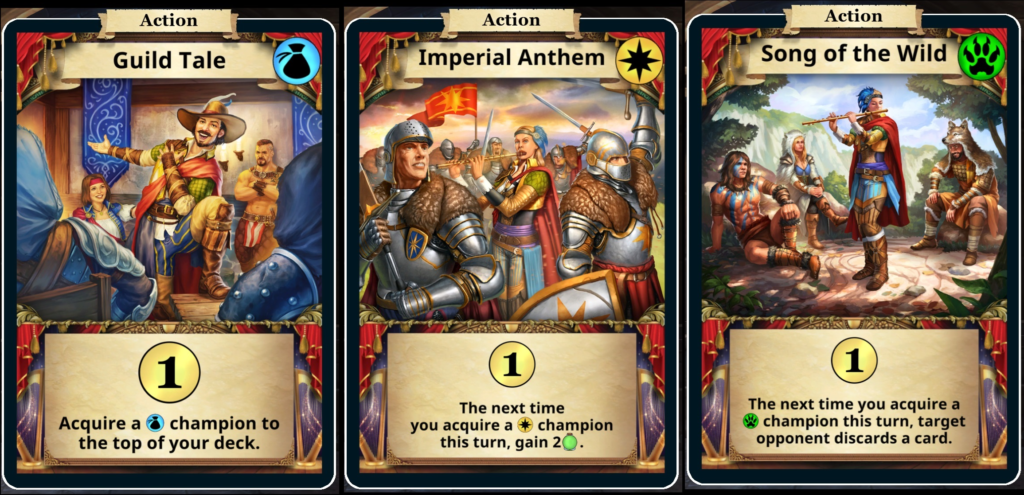
- ‘Guild Tale’ allows for top-decking the next guild champion acquired. This effect can be utilized in a number of ways including squaring off your deck to prevent a deck flip, adding enough damage on the following turn if expecting to clear champs (champions that stun such as ‘Droga – Guild Enforcer’ can be quite useful here), setting yourself up for an economy turn with ‘Ren – Bounty Hunter’ (if your opponent has champions to stun next turn and you can faction or you’re level 9+ and then can use your armour to activate the ally ability for the 3 gold) or simply adding damage/draw/defense by top-decking ‘Parov – The Enforcer’.
- ‘Song of the Wild’ causes your opponent to discard a card upon acquiring a wild champion. The primary use for this card is to slow your opponent’s early game, forcing them to discard a gold and preventing them from adding a premium purchase in their next deck significantly boosts your ability to win the early game before they stabilize their deck. This might stop them adding a high health guard/healing to sustain/damage to clear your champs to their next deck, adding an additional deck cycle before they can begin to retaliate effectively. In particular, using your ability ‘Mythic Chronicle’ (max level ability) in combination with your armour can be devastating with a number of champions, such as ‘Broelyn – Loreweaver’, which results in a discard 3 when paired with ‘Song of the Wild’. To a lesser extent, top-decking abilities such as ‘Brave Story’ (level 1 ability) can also be effective at slowing your opponent with a discard whilst squaring your deck, setting up for an economy turn on your following turn, and so forth. A KEY point here is always make sure you have played ‘Song of the Wild’ BEFORE purchasing a wild champion.
- ‘Imperial Anthem’ provides you with 2 healing upon purchase of an imperial champion. Much less important or complex decision making associated with this song, it can be useful for a minor amount of healing to keep your armour online, perhaps for the aggressive hero match-ups such as fighter and barbarian, but considering the importance of winning QUICKLY for most match-ups if you’re purchasing an imperial champion just to heal, be cautious you aren’t forgoing significant damage output.
Ability EARLY
Your ability is an essential part of putting yourself in a position to win a game quickly, and as such it is particularly important to use this in your FIRST deck cycle. The ability ‘Mythic Chronicle’ allows you to acquire a champion for 3 gold less AND if it costs 5 gold or less, put this champion directly into play.
There are two scenarios in which to use the ability; purchase of a champion of cost 5 or less and putting the champion directly into play; purchase of a champion of cost 6 or more for your next deck shuffle. The latter is self-explanatory; providing you with an almost guaranteed ability to purchase champions such as ‘Tyrannor – The Devourer’ and ‘Grak – Storm Giant’ (unless your hand contains 4 gold only, made possible with ‘Herald’ and four 1 gold/1 economy song cards, but usually a cycle by herald fixes this). The former has a huge array of possibilities, which will be elaborated further on in the ‘Market decisions’ section of this article, but in general you’re looking at champions that provide discard advantage (such as Broelyn – Loreweaver’), have ally ability to draw to accelerate your deck (such as ‘Parov – The Enforcer or ‘Cristov – The Just’), or even both paired with the ‘Song of the Wild’ card (such as ‘Orc Grunt’).
One other scenario, rarer considering the amount of economy your deck has accumulated through the process of acquiring upgrade choices, is the use of your ability to acquire an economy champion to purchase another card on the market, usually a high cost action such as ‘Demonic Cloud’. Champions such as ‘Cult Priest’ and ‘Treasure Seeker’ are great here, but essentially anything that has cost 3 or less will work as it is essentially free with the use of your ability, dropping the cost of the champion from 3 to 0.
Slow your opponent
This is in the form of discards. Using the ‘Song of the Wild’ card to acquire any wild champion, often including lesser wild champions such as ‘Wolf Shaman’; using your ability to bring a champion that has discard as its ally ability into play (Broelyn – Loreweaver) and using your armour to activate a further discard; using your skill to prepare a champion with “discard a card” as its primary action (such as ‘Torgen – Rocksplitter’).
Accelerate your own deck
There are two particular scenarios to note; before claiming your cool armour (BC) and after delivery of your cool armour (AD).
BC depends heavily on how well you use your ‘Herald’ card; he provides the capability to square your deck (5 cards remaining, preventing a deck shuffle), or in some scenarios the ability to UN-square your deck (4 or less cards forcing a deck shuffle). In most scenarios keeping your deck square is especially important when you have champions in play to ensure they do NOT miss a deck flip, particularly in aggressive match-ups and very low-level games where typical game length proceeds more often into the long-game.
UN-squaring your deck may be useful if you purchased 1-2 higher economy cards such as ‘Influence’ and you want to, firstly, keep your single economy cards OUT of your hand after next, and secondly, temporarily tighten your next deck so as to ensure you have a higher economy turn for a premium purchase on the market row. It can also be useful to try and encourage factioning; if you managed on turn 2 to purchase ‘Spark’ and ‘Elven gift’, using herald on turn 2 will force a deck shuffle on turn 4 and increase the likelihood of having both of those cards in a single hand. Preparing your herald is key to the above scenarios as well, which may be more worthwhile than acquiring a firegem.
AD revolves around your armour ‘Coat of Encores’ which allows you to activate an ally ability irrespective of whether or not it has been activated this turn. This. Armour. Rules. In general, considering your deck already contains cards with factions applied to them, any market cards which faction for a draw, discard, ‘prepare a champion’ are particularly worthwhile purchases without the need to have flooded your deck with other factions. Your armour is key to accelerate your damage output without creating unmanageable deck bloat. Cards that faction for a draw are now guaranteed to draw (‘Dark Energy’), cards that faction to discard are now guaranteed to cause your opponent to discard a card. Combined with the uses as described above with your song card effects, you can find yourself top-decking guild champions and drawing them, causing multiple discards, and preparing champions additional times with cards like ‘Rally The Troops’.
Skill almost every turn
Your skill to prepare any number of champions up to a total cost of 10 gold provides a huge source of damage and pace control. If, for example, you had ‘Orc Grunt’, ‘Wolf Shaman’ and ‘Parov – The Enforcer’ in play, equaling a total of 10 gold, you have a total of 16 damage once prepared, not to mention the potential for 2-3 draws with the use of your armour and potential to draw into ‘Guild Tale’, the song card with the guild faction attached.
Your skill also provides the ability to slow your opponent down by preparing champions which cause your opponent to discard (discard 2 as a result), healing such as the use of ‘Cristov – The Just’, transforming every champion which sacrifices into a version of ‘Tyrannor – The Devourer’ by allowing for a second sacrifice of a card of choice, additional economy with the preparation of multiple economy champions, and so forth.
Another point that mixes with the previous section on ‘Accelerate your own deck’ is preparing your ‘Herald’ champion. This helps to maintain the pace of your deck, moving towards those premium market purchases; and puts you in control of how you want your successive decks to form by either keeping single economy cards out by unsquaring your deck, or even by preventing a deck flip by squaring the last 5 cards and keeping champions in.
Considering the particularly broad and sometimes situationally beneficial uses a number of market cards have in combination with your skill, armour, ability and deck song cards, this will be elaborated further in the next section; Market decisions.
Market decisions
Always buys; almost no exception in purchasing these (unless you’re spoilt for choice).
Sacrifice champions; with your skill these are all just as effective as ‘Tyrannor the Devourer’ used by a non-Bard hero in trimming down your deck. If level 16 its worthwhile top-decking the 3 cost or less champions such as ‘Fettered Imp’ or ‘Galok – The Vile’ to save your ability ‘Mythic Chronicle’ for another worthwhile endeavour.
A special mention should be made here to ‘Ritualist Farkir’, who can be expended to sacrifice a card from hand or discard, then gain 1 economy for each card you’ve sacrificed this tun. This includes those that have been scrapped (such as firegems and other cards with the bin icon) and your ability. To note this combines very well with your ‘Goblet of Whimsy’ and ‘Summoning Drum’, providing outrageous economy in return when activated AFTER you’ve scrapped what you can, then preparing him with your skill to add this amount again (with the additional benefit of having sacrificed 2 cards out of your deck).
Discard champions; this INCLUDES both those that have the effect as their primary action or their ally ability, those that cost 5 or less acquired into hand with ‘Song of the Wild’ in play gives you the opportunity to force your opponent to discard 3 cards on their next turn (with the help of your skill/armour depending on if its their primary action or ally ability). ‘Broelyn – Loreweaver’, ‘Torgen – Rocksplitter’, ‘Auberon – Demonslayer’, ‘Den Mother Morga’, ‘Goblin Guardian’, ‘Overseer Ghazat’.
Champions who prepare; again, primary or ally ability is not necessary to determine as both provide incredibly powerful synergies. To note if you ever find yourself able to acquire and play the champions ‘Roland the Sun’s Blade’ and ‘Merriglow the Ministrel’ together, with just those two cards (and 2 economy to activate your skill) you’re able to amass a total of 36 combat and 16 health in one turn!
High defense champions; beneficial obviously for their defensive characteristic, but also for often high combat (especially when preparing with your skill) and their unique effects, such as ‘Grok – Storm Giant’ and this champion’s cycling ability.
Often buys; purchased when there are no ‘always buys’ in the market row.
Draw (action or champion, primary or ally ability); essential for keeping deck pace. ‘Full Moon’s Call’, Cristov – The Just’, ‘Dark Energy’ and ‘Gabarius – Pack Dragon’ are just to name a few. A particular favourite of mine is ‘Orc Grunt’; as an opening card you can acquire this for free with ‘Mythic Chronicle’, force your opponent to discard a card on his next turn if ‘Song of the Wild’ is in play, and achieve 2 draws with the use of its ally ability, giving you a particularly explosive start whilst slowing down your opponent. ‘Gemmla – Wolf Scout’ achieves a similar effect, but is less common to find and gives you a net 1 economy less and 2 combat more (with use of your skill) by end of turn, but does provide a better long term deck investment.
Discard actions; those with the faction ability to discard a card (‘Nature’s Bounty’) are often more valuable than those that cause your opponent to discard as their primary action as they can be activated up to a second time with the use of your ‘Coat of Encores’ armour. However when you’ve stacked enough discard cards together it becomes much of a muchness. The more discard cards you have in your deck, the more VALUABLE additional discard cards are, so this is often situationally an ‘Always buy’ in this scenario.
Sacrifice actions; slower than champions but still useful pending the action in particular such as ‘Last Embrace’, ‘Infernal Reward’, ‘Grave Robbery’, ‘Dark Reward’ as better options than those that have lower yield other than their sacrifice ability such as ‘Demonic Rage’ and ‘Death Touch’.
Damage cards; without damage you won’t find lethal, or simply put, “Damage go brrr” – Tuff (IGN). These include cards such as ‘Bushwhack’, Commander Leandra, ‘Dragged Below’.
Cycle cards; not as good as pure draw cards, but still very useful in maintaining deck pace. These include ‘Elven Gift’, ‘Explore’, and so forth.
Situational buys; such as against specific opponents
Healing champions or actions; ‘Inquisitor’, ‘Taxation’, ‘Recruit’, ‘Inquisitor’s Touch’, the latter being a particularly good economy card with the ability to use your armour to activate the 2 extra gold effect. These cards are more important for aggressive match-ups, such as fighter or barbarian heroes, and as deny buys against wizards, however with most other classes these can be bought minimally to ensure you don’t develop excessive deck bloat.
Token champions; ‘Kasha – The Awakener’ is fantastic if you managed to get her to accrue a large number of protected zombie tokens, as an unlimited number of these can be prepared with your skill considering they cost 0 economy. The same can be said for ‘Bjorn – The Centurion’ from a defensive perspective, great against aggressive classes or those with low deck combat such as clerics and thieves.
Bottom decking cards; for squaring off your deck when you want to sacrifice before a deck flip, keep from bottom-decking champions in play or actions in your last deck hand. These include ‘Imperial Tunneler’, ‘Ratling Welcome’, ‘Ophelia the Twice Blessed’ and so forth.
Anti-necromancer champions; ‘Kalibok – The Defiant’ and his ally ability to deal 2 damage to all opposing champions, ‘Trapmaster Rienne’ and an additional 1 damage for each opposing champion and other mass opposing champion effect cards are a great tool to keep necromancer’s in check.
Special cards
These vary between always buys to often buys, taking note of the use of being able to guarantee an activation of their ally ability as relevant. An extensive list includes the following, but not limited to; ‘Deception’, ‘Command’, ‘Rally The Troops’, ‘Crime Spree’, ‘Rampage’, ‘Smash and Grab’, ‘Varrick of the 10 abs’, ‘Word of Power’, ‘Afterlife’, ‘The Summoning’, ‘Bounty Collection’, ‘Soul Transfer’, ‘Demonic Cloud’, ‘Fearless Charge’, ‘Pack’s Fury’, ‘Pelleas – The Seeker’, ‘Grave Robbery’, ‘Hunt for Jewels’, ‘Ministrel’s Melody’, ‘Prepare for Battle’…. And others (look there’s a lot ok).
Hero Specific Matchups
By the time I finally reached diamond rank for my bard, the following were my win-rate statistics per hero I found myself against.
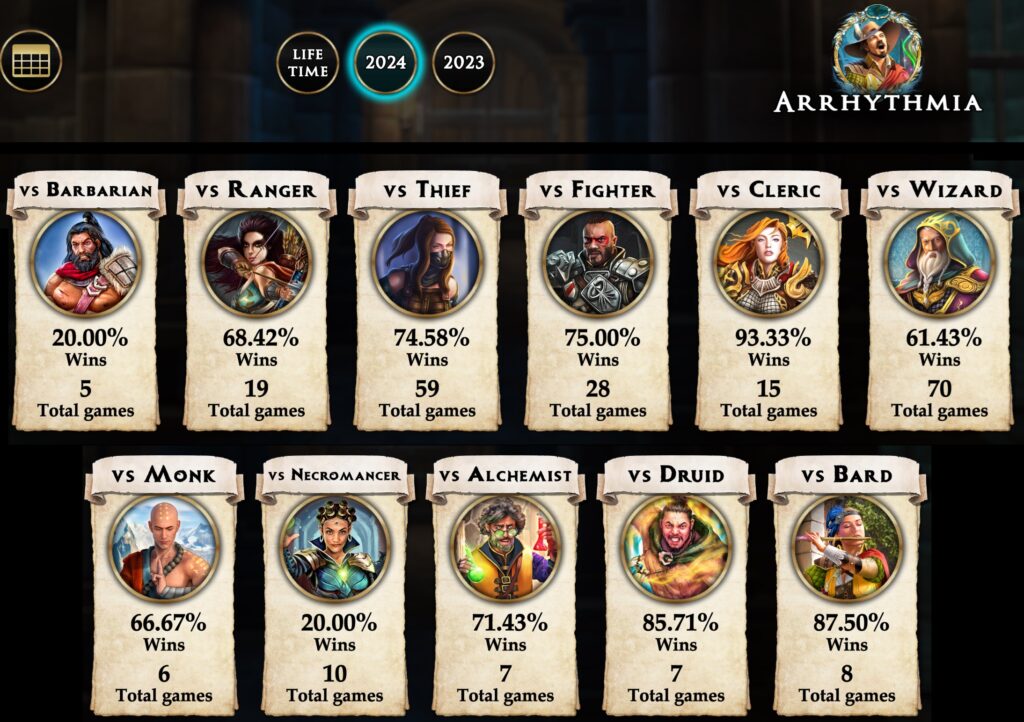
As you can see the sample size for a lot of the beta heroes is particularly low, so here my advice may not be the bees knees so to say, but I will give general tips that will help you against those heroes nonetheless. I won’t be exploring general tips for gameplay, please read the section ‘General Strategy’ for this.
Barbarian
Honestly, an absolutely bloody awful matchup that plays against your strengths; able to accelerate faster than you and carries the damage output needed to shut off your armour EARLY. Champions, healing, champions, healing, oh, and champions. You’re top-decking every guild champion possible with ‘Guild Tale’, making use of bringing others into play with your ability (or purchasing a high defense champion BEFORE your first deck shuffle), squaring off your deck (making your last hand pre-shuffle exactly 5 cards) to make SURE your champions in play don’t miss a deck shuffle, purchasing imperial champions for the 2 healing off of the ‘Imperial Anthem’ card, and so forth. Purchasing cards like ‘Taxation’ or ‘Confiscate’ synergise particularly well with your armour to provide 6 healing, and 12 if you manage to pair this with another imperial card such as the ‘Imperial Anthem’ song.
Skilling each turn to try and whittle away their health as you try and stabilize the amount of incoming damage by having champs soak this up is very important. As IGN Scrapforce would say, “you win by not dying”. Row punching high damage cards (especially those with discard actions) like ‘Elven Curse’ or ‘Intimidation’ and using your economy that turn to instead purchase a champion or two can help in this process.
Ranger
Ranger play isn’t particularly different than tactics outlined in ‘general strategy’, however you do want to be particularly careful of the top-decking capability of the ‘Horn of Need’ level 15 upgrade for ranger. This firstly increases their buying potential so you need to keep premium champions out of play. Secondly it can lead to an early champion wall you might find yourself unable to deal with; the fast acceleration of the Ranger’s deck through their tracking skill means further champions can be purchased and added quite quickly.
Thief
Early champ wall is key here. Thieves can struggle with damage output to knock those down and if you manage to turn off their armour quickly (most likely ‘shadow mask’) then their deck will become incredibly slow. This will give you the opportunity to quite easily outpace a thief, even with a particularly good smooth heist you can still win. The greedier the thief build the easier it is.
Fighter
Fighter play is similar to that of the Barbarian matchup, however you have a much better chance of stabilizing your health loss and turning the match towards you favour. This is because you now have a particularly strong economy advantage with most fighters ignoring the market entirely and a better acceleration. The hardest part of this match-up is keeping your armour online against the double ability fighter (20 damage across 2 opponent turns) in combination with high base deck damage.
Row punch, buy a champ/healing, row punch, buy a champ/healing, row punch, buy a champ/healing.
Cleric
Unless you’re playing low level or have incredibly unlucky market choices, you should be able to achieve a win against a cleric without too much difficulty. Creating a champion wall, denying sacrifice with summoning drum, collecting discard cards (especially champions or those with an ally ability to force a discard), and collecting cards that draw or prepare champions. Using your faster acceleration to snowball with an early ability can really get the game moving quickly, especially if you use it to purchase a high cost champion to begin that champion wall. Making use of the advantage you have over cleric in your base deck with a much better economy and ability to accelerate are key here. In this matchup you should be playing similar to that of a wizard and cleric combined.
To note, if you’re playing a soul cleric with helm, only ever stun the second champion if you’re close to lethal, this really helps to inhibit early premium purchases by the cleric player.
Wizard
This one is a countdown. You need to be winning these by turns 10-11 to have a decent chance. Here you’re playing aggressively. Draw cards, high damage cards, discard cards and denying healing with your ‘Summoning Drum’. The aforementioned list of cards do not need to be of a specific type; champions or actions will both do. Essentially you need to out wizard the wizard, but you do NOT want to be bloating your deck with firegems. Unlike a fighter, you’re relying on market cards for the aggro rush as you cannot win this if you aren’t fully utilizing the effect of your armour by activating ally abilities or your skill to prepare champions for bursts of damage.
In this match-up you need to be most aware of a wizard’s ‘Explosive Fireball’ ability, as this forces you to discard any champions of defense 5 or less from your hand and prevents you from purchasing champions from the market for a turn. Carefully paying attention to when this may occur, and making sure you have your turn after next ready to react to purchase what may be left in the market is important. This may be as simple as making sure your deck is square with the ‘Herald’ (which may require you to NOT activate him during a turn) so you don’t cause a shuffle before adding to your next deck.
Monk
Monk’s do better in the mid-game considering their explosive abilities to draw cards and high deck damage/healing, not to mention an almost guaranteed draw off of their ‘Slippers of the Crane’ armour. One exploitable weakness is how strong their deck is with very few cards added; deck clogging often results in not acquiring enough Tau Lu actions in a turn, difficulty deck flipping and bottom decking special Tau Lu actions for healing and damage, reducing total Tau Lu counts and therefore healing and damage output proportionately.
If you can manage an early sacrifice champion and keep high damage cards away from a monk, whilst buying card draws, discards, and so forth, you can start to outpace a Monk and push it to the late-game to finally be able to whittle their health down (prior to this they often have 16+ healing from their ability/abilities).
Necromancer
Its rough. You need a big champ or to keep your deck cycling as fast as possible to make sure each hand has damage +/- healing in it; this means cards like ‘Dark Energy’ are a premium, as well as ‘Taxation’ and ‘Confiscate’. Making use of a Necromancer’s low purchase capability is important to try and survive whilst gradually building up your deck to make a comeback. Sacrifice is essential to this, so any sacrifice champion will do. Be mindful that if you are going to play the high defense champion that your next hand has enough damage to stun it, as more often than not your necromancer opponent will use their ability to steal it from you!
Be wary to keep cards that benefit a necromancer out of their deck, such as ‘Close Ranks’, ‘Master Weyan’, ‘Devotion’, etc. Cards that are beneficial against a Necromancer specifically are all that apply mass damage, such as ‘Trap Master Rienne’ and ‘Apprentice Trapmaker’, always ensure you activate these twice before clearing champions to accumulate maximum combat.
Further details regarding how to counter this class can be found on the Realms Rising article ‘Bone Dancing to Diamond; A Necro’s Journey (Levels 1-16)’, written by IGN Tuff.
Alchemist
Same concept as wizard, only you’ve a better chance at champion walling here considering the Alchemist hero doesn’t have the same damage on command capability as the Wizard hero with it’s various fireball abilities. The exception here is if your opponent chose the ‘Brittle Gas’ upgrade, which reduces all opposing champions defense to 1 on card sacrifice.
Druid
Druids aren’t particularly susceptible to the early-mid game as some of the other classes, so its important to try and push this one into the late game. Your goal is to add market cards to ensure you have damage to clear bear forms and forest critters, which means you may not sacrifice your ‘Goblet of Whimsey’ card until you need to clear a champion, whilst trying to survive the burst damage a druid may have should it have the ‘Ursine Rod’ card in its deck to bring a SECOND bear form into play.
Bard
May the best of us prevail in our songs of glory! Always first assess the opponent’s deck, what skill and ability/abilities have they chosen. Essentially this is a time to really flex your understanding of bard play; have they played ‘Song of the Wild’ yet and should I pre-emptively buy ‘Wolf Shaman’? Do they have ‘Guild Tale’ in their next hand and does buying ‘Ren – Bounty Hunter’ give them the econ to purchase the ‘Firebomb’ currently on the row?
Alternative Build and Other Musings by IGN lgkstwrt
Asawesomas has accomplished fame for being the first Diamond Bard out there. And while I am slowly and painfully on my way to join, I would be remiss to tell you how difficult this journey is. In the current meta, the extra wily wizards and the brutal barbarian matchups often make quick work of the humble Bard. Matching with a Necromancer spells almost certain doom, while queuing against a Cleric is an almost guaranteed win. All of this is really just due to the Bard being extremely market dependent and squishy.
That said, I spent about half of my Bard journey working a slightly different build than my counterpart above, chiefly differing in three ways. This build got me up to Platinum and then I started struggling. The main differences were:
- Choose Necros Dirge over Dancing Blade
- Choose Lullaby Harp over Golden Harp
- Choose Rally Hymn over Battle March

Necros Dirge:
One of the primary reasons I choose the Necros Dirge over the Dancing Blade is because this card is a control card. You play this card to combo it with purchasing a Necros card from the Market and you get to sacrifice a card from hand or discard. If you get lucky enough to have this in play and snag Ritualist Farkir early, you can clean your deck out quickly. While the 1 combat isn’t as nice as the 2 combat from the Blade, the combo is certainly sweet. However, if the Market doesn’t cooperate, this card can just drag around and not do much for your deck.
Lullaby Harp:
If Bard doesn’t get healing against an aggro class, Bard will die quickly. The Lullaby Harp can help mitigate this a little longer than the Golden Harp, especially if you have a thin deck. I’ve also had a few games where the expend feature has been very helpful, especially if the game is early and I don’t have enough damage yet to clear a champion. Nevertheless, I think the Golden Harp has probably been more advantageous to me than the Lullaby was, so I might lean the Golden Harp as the way to go. If I know I’m going to face an aggro opponent, I would probably choose Lullaby Harp still, but anything else and I think I’d take the Golden Harp.
Rally Hymn:
When I first started playing around with Bard, back before Battle March was nerfed, I ran the Battle March build. After the nerf, though, I swapped over to Rally Hymn. This is the biggest difference between our builds. Rally Hymn is the middle upgrade of the skill tree. It allows you to prepare champions up to a total cost of 7, and buffs them all +1 defense. The downside of this skill is that it will miss on the Big Bad 8-cost champs. The upside is that you get some serious defense added, which helps mitigate that damage effect. This is particularly brutal when you have a bunch of low-cost champions out there on the line.
Do I wish I could prepare Tyrannor or Lumina? Absolutely. Regardless, the plethora of 7-cost devastation is still very effective, and I certainly value the defense added.
Other Items of Note:
- Base set is hard
- Playing Bard with only the Base Hero Realms set seems to be more difficult than combining additional sets of cards. Maybe it’s because the ally abilities aren’t as strong and the top & bottom deck mechanics are not present. Or maybe it’s just me, but in the Base-set only games, I struggled more to win than with other sets.
- Little champions are wonderful
- Usually the weak 2-4 cost champions would fall low on the tier lists. Everyone loves to hate on Tithe Priest or Veteran Squire (or Con Artist), but the potential synergies and damage output (or healing effects) should not be underrated. I had one game where I had both Veteran Squires and two other low Imperial champions. That’s 32 damage from preparing both Veteran Squires!
- Bard is the better cleric. Bard is the thief alchemist cleric.
- The real fun of Bard is it just does a great job of feeling like several other classes, but doing it well and somewhat differently. You get the rush of a smooth-heist like purchase to hand. You get the thrill of managing a champion wall. You get to play around with a rainbow deck like the Alchemist.
- Prepare to Die
- You will lose a lot. If the market doesn’t give you many champions, or you get no healing against an aggro class, you’re going to lose. This can certainly be a frustrating experience, or you can take those losses and weave a tragic song that will be handed down for ages to come.
